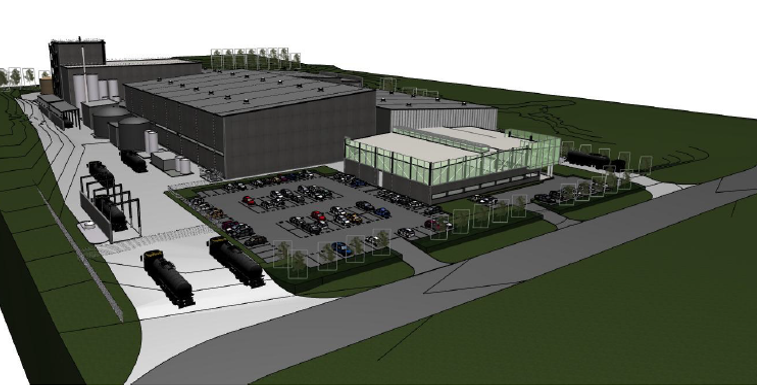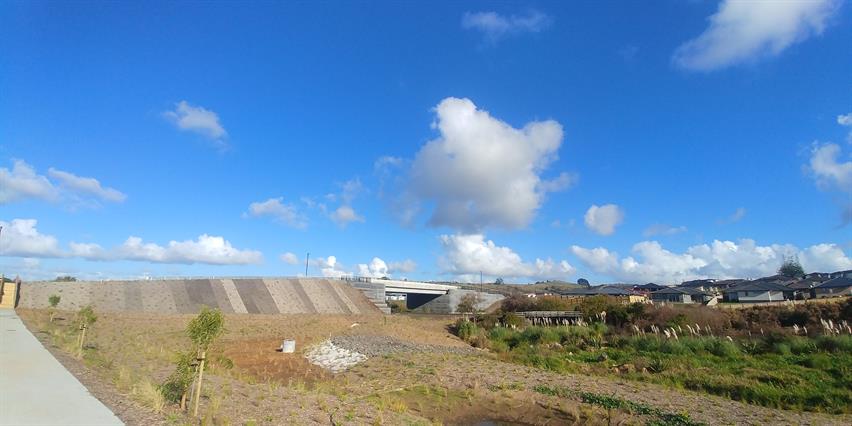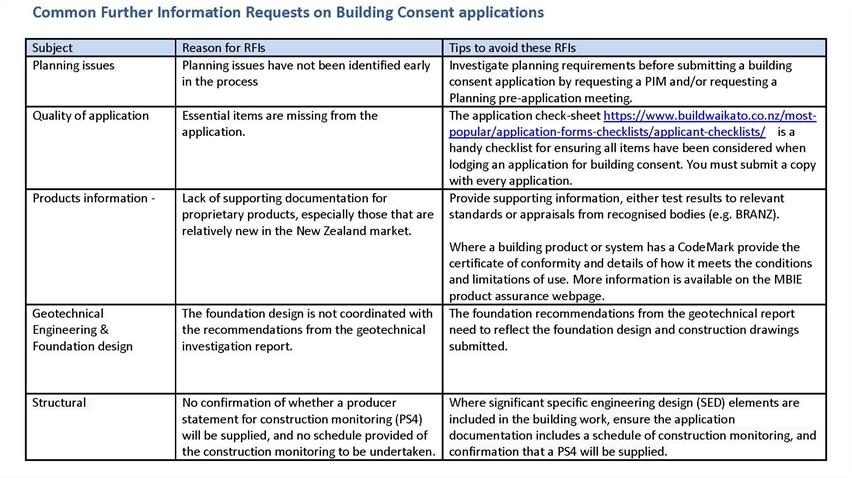
Here’s the latest information about building
consents and resource consents from Waikato District Council.
If you wish to receive this via email, you can subscribe here.
In this issue:
Changes you need to know about:
Helpful tips and reminders:
Team update
Consents Team Update
The Resource Consent team continue to be busy with applications being lodged for developments across the district.
Getting us through all this work is a team of approximately 40 people and in the past 6 months we have had a few changes:
- In the planning teams we have said farewell to Cameron Aplin who is now with BCD, but welcomed Georgia Morton and Wade Hill as Consents Team Leader and who we profiled in our March edition.
- In the engineering team we have welcomed back Peter Henderson (returned from Auckland Council) who is now based in the Tuakau office, and welcomed Mel Montesa who has joined us from Taupo Council.
- In the admin team we have said farewell to Dianne Keast, who has retired, and welcomed Hiria Hetet, Bethney Waters, and Charmaine Nukanuka.
Sadly we have also said farewell to Jodi Bell-Wymer who is moving to another role in Council. We have several vacancies (Technical Planner and Planners) for which we are currently recruiting.
Building Team update
The consent numbers are a little down on last years’ numbers, which is allowing us to focus on other key tasks such as pool inspections. These inspections are required by legislation that came into force in January 2017, and they need to be carried out on every pool in the district, once every three years.
The inspections focus on the safety of the pool fencing, which contributes toward keeps our communities safe. We are on track to meet this statutory requirement.
It also means we are able to concentrate on identifying Earthquake prone buildings and notifying owners of their responsibilities. This is also part of our legislative duties and we have been able to help other councils in the Waikato Building Consent Group with inspection and processing assistance.
The Building Team is currently going through a process of integrating the Planning and Engineering Officers (PEOs) into the team. The aim is to have the PEOs and the Building Review Officers (BROs) combined into one role. This change will give the team more flexibility in terms of processing consents and provide cover for leave and sickness.
We are receiving 81.89% of building consents in a digital format, this is down on the 90% we were receiving. We’re hearing this is saving you money and time and so would encourage you to submit digitally. If you are unsure on how to submit digitally, please contact our friendly staff at council on 0800 492 452 and ask for the building desk to get some guidance.
Staff Profile, Meet our team:
Terrence Hayes
“I was born in Palmerston north but didn’t like the cold, so moved to Hamilton when I was two and have lived here ever since.
I have worked at another nearby council as a Building Review Officer and prior to that was employed as an architectural draftsman. I am the chairman for the BOINZ (Building Officials Institute of New Zealand) Waikato/BOP branch. Tasked with providing quarterly training days for its members.
I enjoy exploring new countries, cycling, weightlifting and riding or driving anything with a motor in it.”
David Samson

“I’m born and bred in Hamilton, a qualified builder by trade. I worked in Australia for the best part of 6 years, with a bit of traveling beyond while I was there, before returning to Hamilton.
I have spent time working in the Building unit at Thames Coromandel District Council and Hamilton City Council.
I enjoy playing football, golf, running, diving, snowboarding and putting the tool-belt back on to work around home.”
Processing statistics
Here are the latest numbers for building and resource consents, as well as LIMs and new lots.
What's happening:
Pokeno Nutritional Park
Resource consent has been granted to construct and operate a Nutritional Facility with an Industry Park concept within the Light Industrial Zone, Pokeno. This is the third value added dairy and food factory to be constructed in Pokeno.
The development will include a small size spray dryer specially designed for producing a range of formulated dairy products and nutritional powders. As a retail packing plant, potential facilities could include canning, single serve sachet packing, other Nutritional Food Plants which could produce butter, cheese or other similar product reworking lines, as well as innovation and New Product Development facilities. The development will be starting this year and will be executed by stages.
This development will provide employment opportunities for projected growth within the district, with up to 100 job opportunities once the plants are fully operational.

Pokeno’s Hitchen Road bridge is now open to the public
Dines Fulton Hogan representative Colin Botica says the bridge is a great asset for Pokeno. “The bridge provides connectivity for residents to the school and the central business district.”
The bridge was built and funded by Dines Fulton Hogan and is to be vested as a Council asset. Minor works are still being completed on the footpath side of the bridge. Once this has been completed an official opening will be organised.

The National Monitoring System
The National Monitoring System (NMS) monitors the implementation of the Resource Management Act 1991 (RMA). Under the NMS, local authorities are required to provide detailed data each year to the Ministry for the Environment. From this data, the Ministry releases a summary of key resource consent related statistics across all Councils. You can read more about this on the Ministry for the Environment website.
The data for the 2017/2018 year has been released; some interesting results are as follows:
- We issued 553 land use consents and 384 subdivision consents
- We ranked 2nd behind only Auckland Council for the number of subdivision consents processed; and 8th for the number of land use consents processed (including unitary authorities)
- We limited notified 6 consents and publicly notified 2 consents.
- We processed 99% of consents on time
- Across New Zealand, 86% of all resource consents were processed on time
- Across New Zealand, 99.7% of all resource consents processed were granted
Process focus:
Consulting with Council’s Asset Managers and Pre Application Service
Does your proposal involve:
- Vesting land as reserve in Council?
- Use of a Council reserve for a temporary event?
- Use of a Council reserve for vehicular access to your property?
- Upgrading of Council’s reticulated water or wastewater infrastructure?
- Upgrading of Council’s road network?
- Building within the setback from a Council road?
In these circumstances, early consultation with Council’s Asset Managers from our Waters, Roading, Open Spaces or Property Teams is important. These teams need time and information to consider your proposal before any subdivision or
land use consent is lodged.
Please remember if you have a complicated proposal that you need to discuss with Council our pre-application service is also available.
The pre-application service is particularly useful in ensuring that you provide all the information you need with your resource consent application.
Changes to fees and charges
On 1 July Council will be implementing the second year’s fees and charges as stated in Council’s Fees and charges booklet.
These will come into effect on 1 July 2019. Here is some important information you need to know:
A final reconciliation will be carried out on all applications at time of final billing. When this is done for subdivision consents the appropriate 223 Certificate charge will be applied and for Land use consents the appropriate monitoring charge will
be added. These charges need to be paid on the final account. Prior to signing a 224 certificate all processing costs will be required to be paid along with any applicable Development Contributions.
t will provide an opportunity to discuss your application with a Council planner and engineer, and possibly other departments of Council depending on the nature of your proposal.
Identifying up front what you need to gather in relation to this will help avoid possible delays in obtaining missing information further down the track.
Changes to be aware of
Proposed District Plan Update
Deadline extended for further submissions on Proposed Waikato District Plan
Council has extended the deadline for making a ‘further submission’ on the Proposed Waikato District Plan (Stage 1) while it reviews and corrects omissions from the Summary of Submissions it issued last month.
The Council has discovered that a handful of the nearly 1,000 submissions were not published in its Summary of Submissions for its community to consider in order to make a ‘further submission’, and several other submission summaries needed minor corrections.
Council says it is extending the original deadline of Monday 27 May and it will announce a new closing date for further submissions once it is certain it has corrected and published all omissions.
Waikato District Council Chief Executive Gavin Ion says, “We’ve apologised to the submitters involved, we’ve notified all other submitters, we’ve announced it on our website where anyone making a further submission will see it, and so we’re now making sure that our whole community is aware that they have extra time to make a further submission.”
“Once we have a new timeframe we will apply it to all further submissions to give our community a fair chance to look at all the original submissions together. This will also serve to provide extra time for the community to consider what might be important to them,” says Mr Ion.

Helpful tips and reminders
Here are some tips and reminders that we hope will make it easier for you when you are working with us, or when you are compiling an application.
Some things to look out for during the 223/224c subdivision process.
In General Accordance with the plan:
Council has some discretion in accepting changes to the size in Lots as long as the changes are within ‘General Accordance’ with the subdivisions approved scheme plans. However, when these changes alter the shape and size of a Lot in more than a minor way or make the new lots non-compliant with a district plan rule, be mindful that your client(or the applicant) may need to apply for a s127 or apply for a new consent to have the changes accepted.
NZ Geotechnical Database
The NZ Geotechnical Database is available to professional engineering companies, including those involved with Canterbury Recovery, local and central Government officials, scientific and academic institutions, the Earthquake Commission, and insurers.
These organisations may use the registration process below to gain a user name and login. A User Guide, Data Specification and Terms of Access are available for download once a user has logged in.
Please contact support@nzgd.org.nz for further assistance.
https://www.nzgd.org.nz/HelpSupport/AboutNZGD.pdf

Reasons for failing the final inspections:
- Works not fully completed at time of final inspection booking resulting in a failed inspection.
- Building elements or construction changing during the build and amendments have still not been received and approved.
- Documentation not received for CCC completion.
- Work has been completed some time ago this varies between 5 and 20 years in some cases and puts Council in a position where it cannot approve a final inspection or issue the CCC as Council cannot be satisfied that the building elements will meet there
durability requirements.
- Contractual agreements - The developer may have completed their part of the contract but there are some owners care items that are not completed. For example, the owner will be tiling the wet areas, painting the exterior of the house etc.
If the owners care items are part of the work required to be completed for the building consent, then regardless of who does this work, Council cannot approve the final inspection or issue a CCC.
We’d love to get your feedback
We’re interested in what you think about this newsletter so we can improve it over time. Click here to provide feedback.